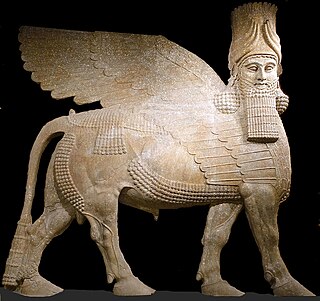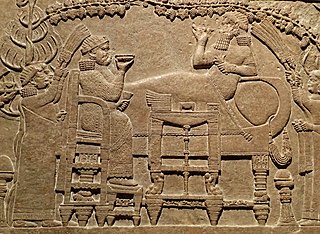
Sennacherib was the king of the Neo-Assyrian Empire from the death of his father Sargon II in 705 BC to his own death in 681 BC. The second king of the Sargonid dynasty, Sennacherib is one of the most famous Assyrian kings for the role he plays in the Hebrew Bible, which describes his campaign in the Levant. Other events of his reign include his destruction of the city of Babylon in 689 BC and his renovation and expansion of the last great Assyrian capital, Nineveh.

Tiglath-Pileser III, was the king of the Neo-Assyrian Empire from 745 BC to his death in 727. One of the most prominent and historically significant Assyrian kings, Tiglath-Pileser ended a period of Assyrian stagnation, introduced numerous political and military reforms and more than doubled the lands under Assyrian control. Because of the massive expansion and centralization of Assyrian territory and establishment of a standing army, some researchers consider Tiglath-Pileser's reign to mark the true transition of Assyria into an empire. The reforms and methods of control introduced under Tiglath-Pileser laid the groundwork for policies enacted not only by later Assyrian kings but also by later empires for millennia after his death.
Shalmaneser IV was the king of the Neo-Assyrian Empire from 783 BC to his death in 773 BC. Shalmaneser was the son and successor of his predecessor, Adad-nirari III, and ruled during a period of Assyrian decline from which few sources survive. As such his reign, other than broad political developments, is poorly known. Shalmaneser's time was marked both by an increase in the power held by Assyrian officials relative to that of the king and Assyria's enemies growing increasingly powerful. Most of Shalmaneser's military efforts were spent warring against the Kingdom of Urartu in the north, which during this time was reaching the peak of its power.

Sargon II was the king of the Neo-Assyrian Empire from 722 BC to his death in battle in 705. Probably the son of Tiglath-Pileser III, Sargon is generally believed to have become king after overthrowing Shalmaneser V, probably his brother. He is typically considered the founder of a new dynastic line, the Sargonid dynasty.

Shalmaneser V was the king of the Neo-Assyrian Empire from the death of his father Tiglath-Pileser III in 727 BC to his deposition and death in 722 BC. Though Shalmaneser V's brief reign is poorly known from contemporary sources, he remains known for the conquest of Samaria and the fall of the Kingdom of Israel, though the conclusion of that campaign is sometimes attributed to his successor, Sargon II, instead.
Ashur-dan III was the king of the Neo-Assyrian Empire from 773 BC to his death in 755 BC. Ashur-dan was a son of Adad-nirari III and succeeded his brother Shalmaneser IV as king. He ruled during a period of Assyrian decline from which few sources survive. As such his reign, other than broad political developments, is poorly known. At this time, the Assyrian officials were becoming increasingly powerful relative to the king and at the same time, Assyria's enemies were growing more dangerous. Ashur-dan's reign was a particularly difficult one as he was faced with two outbreaks of plague and five of his eighteen years as king were devoted to putting down revolts.

Shamshi-Adad V was the King of Assyria from 824 to 811 BC. He was named after the god Adad, who is also known as Hadad.
ErishumI or Erišum II, the son and successor of Naram-Sin, was the king of the city-state Assur from c. 1828/1818 BC to 1809 BC. Like his predecessors, he bore the titles “Išši’ak Aššur” and “ensí”. The length of Erishum II's reign is uncertain, however; based on various excavated "limmu" (eponym) lists, Naram-Sin's and Erishum II's reigns had a combined length of 64 years.

The history of the Assyrians encompasses nearly five millennia, covering the history of the ancient Mesopotamian civilization of Assyria, including its territory, culture and people, as well as the later history of the Assyrian people after the fall of the Neo-Assyrian Empire in 609 BC. For purposes of historiography, ancient Assyrian history is often divided by modern researchers, based on political events and gradual changes in language, into the Early Assyrian, Old Assyrian, Middle Assyrian, Neo-Assyrian and post-imperial periods.

The Neo-Assyrian Empire arose in the 10th century BC. Ashurnasirpal II is credited for utilizing sound strategy in his wars of conquest. While aiming to secure defensible frontiers, he would launch raids further inland against his opponents as a means of securing economic benefit, as he did when campaigning in the Levant. The result meant that the economic prosperity of the region would fuel the Assyrian war machine.

The Neo-Assyrian Empire was the fourth and penultimate stage of ancient Assyrian history and the final and greatest phase of Assyria as an independent state. Beginning with the accession of Adad-nirari II in 911 BC, the Neo-Assyrian Empire grew to dominate the ancient Near East throughout much of the 8th and 7th centuries BC, becoming the largest empire in history up to that point. Because of its geopolitical dominance and ideology based in world domination, the Neo-Assyrian Empire is by many researchers regarded to have been the first world empire in history. At its height, the empire was the strongest military power in the world and ruled over all of Mesopotamia, the Levant and Egypt, as well as portions of Anatolia, Arabia and modern-day Iran and Armenia.
"Turtanu" or "Turtan" is an Akkadian word/title meaning 'commander in chief' or 'prime minister'. In Assyria, the Turtanu ranked next to the king.

The timeline of ancient Assyria can be broken down into three main eras: the Old Assyrian period, Middle Assyrian Empire, and Neo-Assyrian Empire. Modern scholars typically also recognize an Early period preceding the Old Assyrian period and a post-imperial period succeeding the Neo-Assyrian period.

The Sargonid dynasty was the final ruling dynasty of Assyria, ruling as kings of Assyria during the Neo-Assyrian Empire for just over a century from the ascent of Sargon II in 722 BC to the fall of Assyria in 609 BC. Although Assyria would ultimately fall during their rule, the Sargonid dynasty ruled the country during the apex of its power and Sargon II's three immediate successors Sennacherib, Esarhaddon and Ashurbanipal are generally regarded as three of the greatest Assyrian monarchs. Though the dynasty encompasses seven Assyrian kings, two vassal kings in Babylonia and numerous princes and princesses, the term Sargonids is sometimes used solely for Sennacherib, Esarhaddon and Ashurbanipal.
The Early Assyrian period was the earliest stage of Assyrian history, preceding the Old Assyrian period and covering the history of the city of Assur, and its people and culture, prior to the foundation of Assyria as an independent city-state under Puzur-Ashur I c. 2025 BC. Very little material and textual evidence survives from this period. The earliest archaeological evidence at Assur dates to the Early Dynastic Period, c. 2600 BC, but the city may have been founded even earlier since the area had been inhabited for thousands of years prior and other nearby cities, such as Nineveh, are significantly older.

King of the Four Corners of the World, alternatively translated as King of the Four Quarters of the World, King of the Heaven's Four Corners or King of the Four Corners of the Universe and often shortened to simply King of the Four Corners, was a title of great prestige claimed by powerful monarchs in ancient Mesopotamia. Though the term "four corners of the world" does refer to specific geographical places within and near Mesopotamia itself, these places were thought to represent locations near the actual edges of the world and as such, the title should be interpreted as something equivalent to "King of all the known world", a claim to universal rule over the entire world and everything within it.

King of the Universe, also interpreted as King of Everything, King of the Totality, King of All or King of the World, was a title of great prestige claiming world domination used by powerful monarchs in ancient Mesopotamia. The title is sometimes applied to God in the Judeo-Christian and Abrahamic tradition.

King of Sumer and Akkad was a royal title in Ancient Mesopotamia combining the titles of "King of Akkad", the ruling title held by the monarchs of the Akkadian Empire with the title of "King of Sumer". The title simultaneously laid a claim on the legacy and glory of the ancient empire that had been founded by Sargon of Akkad and expressed a claim to rule the entirety of lower Mesopotamia. Despite both of the titles "King of Sumer" and "King of Akkad" having been used by the Akkadian kings, the title was not introduced in its combined form until the reign of the Neo-Sumerian king Ur-Nammu, who created it in an effort to unify the southern and northern parts of lower Mesopotamia under his rule. The older Akkadian kings themselves might have been against linking Sumer and Akkad in such a way.

The queen of the Neo-Assyrian Empire was the consort of the Neo-Assyrian king. Though the queens derived their power and influence through their association with their husband, they were not pawns without political power. The queens oversaw their own, often considerable, finances and owned vast estates throughout the empire. To oversee their assets, the queens employed a large administrative staff headed by a set of female administrators called šakintu. Among the duties of the queens were religious responsibilities and overseeing parts of the royal palaces; their role as "rulers of the domestic realm" is reflected in their title as "Women of the Palace". The power and influence of the queens was increased further under the Sargonid dynasty (722–609 BC), when they more frequently appear in artwork and large military units directly subservient to the queen were created.
![]()
![]()
![]()
![]()
![]()
![]()
![]() Aššur-daʾʾin-aplu, [1] [2] [3] meaning "Ashur is the heir's judge") [4] [5] was an ancient Assyrian prince of the Adaside dynasty and palace official with the title ša pān ekalli. He is explicitly identified in a letter as the "son of Shalmaneser", a name only used by Assyrian kings. Though a precise date of the documents that mention him has not been established, the Shalmaneser referenced is either Shalmaneser III (r. 859–824 BC) or, more probably, Shalmaneser V (r. 727–722 BC). If he was the son of Shalmaneser V, Ashur-dain-aplu survived the political turmoil in the aftermath of the deposition and death of his father and the rise of his successor, Sargon II (r. 722–705 BC), to the throne, and continued to retain a prominent political position thereafter, possibly as late as the reign of Esarhaddon (r. 681–669 BC).
Aššur-daʾʾin-aplu, [1] [2] [3] meaning "Ashur is the heir's judge") [4] [5] was an ancient Assyrian prince of the Adaside dynasty and palace official with the title ša pān ekalli. He is explicitly identified in a letter as the "son of Shalmaneser", a name only used by Assyrian kings. Though a precise date of the documents that mention him has not been established, the Shalmaneser referenced is either Shalmaneser III (r. 859–824 BC) or, more probably, Shalmaneser V (r. 727–722 BC). If he was the son of Shalmaneser V, Ashur-dain-aplu survived the political turmoil in the aftermath of the deposition and death of his father and the rise of his successor, Sargon II (r. 722–705 BC), to the throne, and continued to retain a prominent political position thereafter, possibly as late as the reign of Esarhaddon (r. 681–669 BC).











